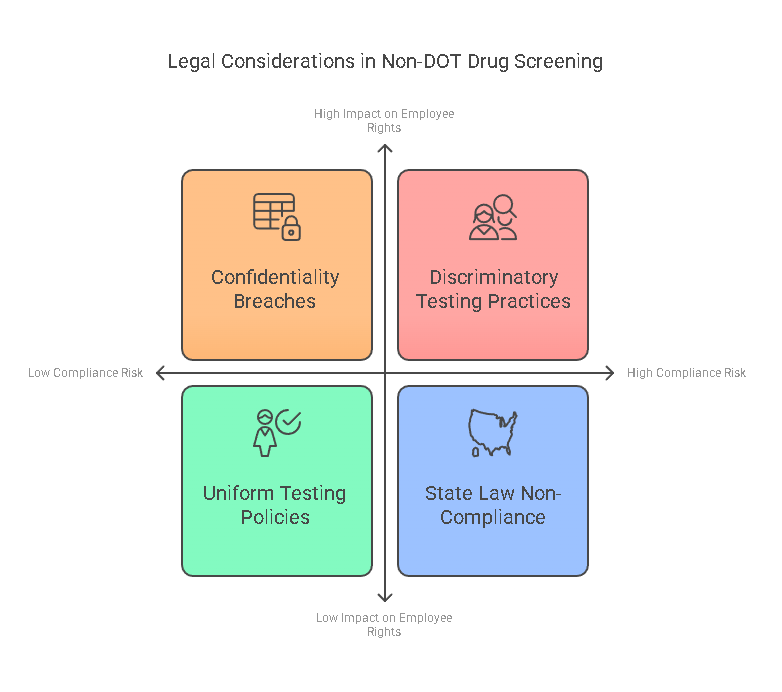Non-DOT Drug Screening Explained: Key Differences, Benefits, and Legal Requirements
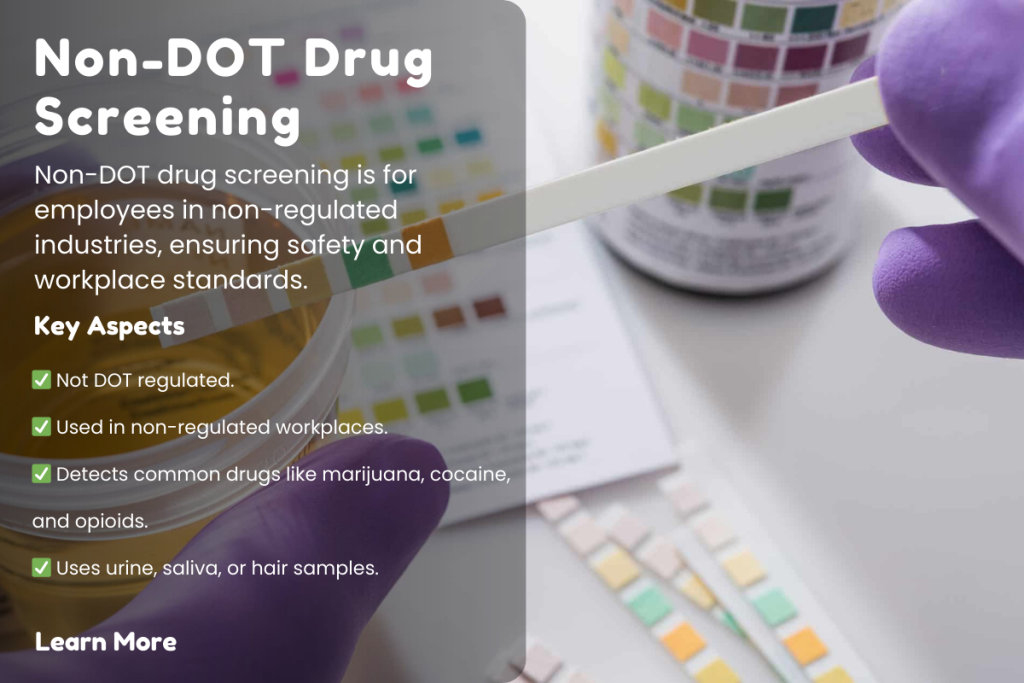
Introduction to Non DOT Drug Screening: What Is Non DOT Drug Screening?
Non-DOT drug screening refers to the process of drug testing conducted by organizations and businesses that are not required to follow the Department of Transportation (DOT) regulations. These types of screenings are used to ensure a safe and healthy work environment by testing employees or candidates for the presence of illegal substances. Non-DOT drug testing is typically implemented by private companies, non-governmental organizations, and various other entities that do not fall under the jurisdiction of DOT regulations.
The term “non-DOT” refers to drug testing policies that are separate from the specific drug and alcohol testing standards established by the DOT for safety-sensitive positions in transportation industries. Unlike DOT testing, which involves stricter requirements and oversight, non-DOT drug screenings are more flexible and can be customized to the needs of the employer or organization.
While the DOT mandates drug testing for transportation workers like commercial drivers and airline pilots, non-DOT drug testing allows employers in other industries to maintain a drug-free workplace by determining whether their employees are engaging in substance abuse. By ensuring that employees are not impaired by drugs or alcohol, non-DOT drug screenings help improve overall workplace safety, productivity, and legal compliance.
Differences Between Non DOT and DOT Drug Screening
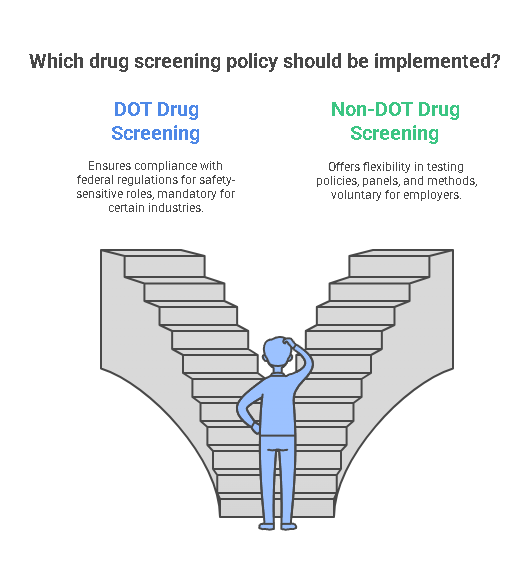
Non-DOT drug screening differs significantly from DOT drug testing in terms of its regulations, procedures, and requirements. DOT drug testing is governed by federal law and applies specifically to employees in safety-sensitive roles in the transportation sector. The regulations that govern DOT testing are outlined in 49 CFR Part 40, which sets forth requirements for testing, reporting, and record-keeping.
Non-DOT drug screening, on the other hand, is subject to fewer federal regulations. It is generally governed by state and local laws, and each employer has more flexibility in determining their drug testing policies. Non-DOT screenings allow employers to choose their own drug panels, testing methods, and frequency of testing. This is in contrast to DOT testing, which has a set list of prohibited substances, standardized testing methods (such as urine testing), and required test frequencies.
For example, DOT drug testing is mandatory for commercial drivers, airline workers, and others in safety-sensitive positions. On the other hand, non-DOT drug testing is typically voluntary for employers, who choose to implement drug screening for a variety of reasons, such as improving workplace safety, ensuring employee productivity, or preventing workplace accidents.
Types of Drug Tests in Non DOT Drug Screening
Non-DOT drug screenings utilize a variety of testing methods, depending on the specific needs of the employer. These tests are designed to detect the presence of illegal drugs or controlled substances in an individual’s system. The most common types of drug tests used in non-DOT drug screening include:
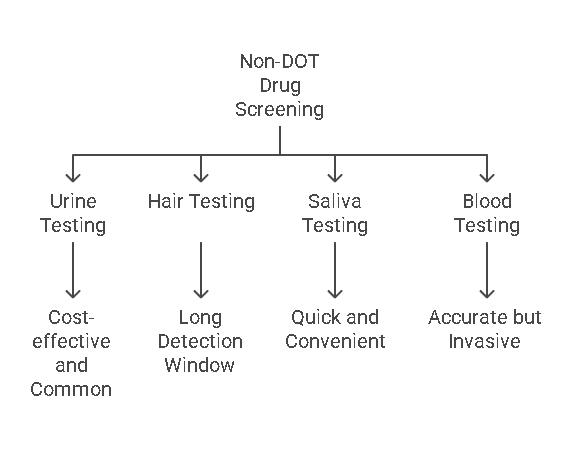
- Urine Testing: Urine tests are the most commonly used method for non-DOT drug screenings. They are inexpensive, non-invasive, and provide reliable results for detecting recent drug use. Urine tests can detect a variety of substances, including marijuana, cocaine, opioids, and amphetamines.
- Hair Testing: Hair follicle testing is another popular option for non-DOT drug screening. This method provides a longer window of detection than urine testing, as it can detect drug use up to 90 days prior to the test. Hair testing is often used to identify long-term drug use or to establish a history of substance abuse.
- Saliva Testing: Saliva tests are quick and easy to administer, making them ideal for random testing in the workplace. Saliva tests typically detect drugs that have been used in the last 24 to 48 hours. This method is non-invasive and can be conducted on-site, which makes it a convenient option for employers.
- Blood Testing: Blood tests are the most accurate method for detecting the presence of drugs in the system, but they are also more invasive and expensive. Blood tests are typically used when a more precise measurement of drug levels is required, such as in cases of accidents or suspected intoxication.
Each of these drug testing methods offers unique advantages and drawbacks. Urine testing is the most cost-effective and commonly used, but hair testing provides a longer detection window. Saliva and blood tests are useful for specific situations, such as random testing or immediate drug use detection.
Who Uses Non DOT Drug Screening?
Non-DOT drug screenings are widely used across various industries, particularly by employers who want to maintain a drug-free workplace. Private companies in industries such as healthcare, finance, technology, and retail often implement drug testing policies to ensure employee safety, reduce accidents, and promote a healthy work environment. These screenings are not required by law for most employers, but they offer significant benefits in maintaining workplace integrity.
In addition to private employers, non-DOT drug screening is also utilized by non-governmental organizations, sports organizations, educational institutions, and other entities that need to ensure their members are not impaired by drugs. For instance, some schools conduct drug tests for students participating in extracurricular activities, while sports teams may test athletes to prevent performance-enhancing drug use.
Non-DOT drug screening is particularly common in industries that are not governed by DOT regulations but still require a high level of safety and responsibility. This includes positions that may involve heavy machinery, patient care, or roles where employee performance is critical to the success of the organization.
The Importance of Non DOT Drug Screening for Employers
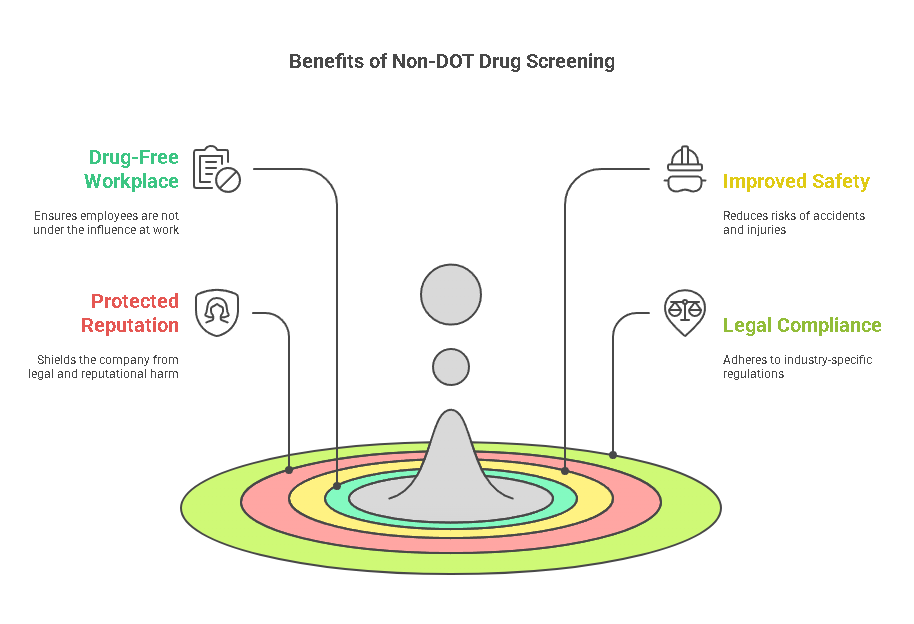
For employers, implementing non-DOT drug screening is crucial for maintaining a safe and productive workplace. Some of the key benefits include:
- Maintaining a Drug-Free Workplace: Drug screening helps prevent employees from coming to work under the influence of drugs, which can lead to accidents, injuries, and lower productivity. By ensuring that employees are not impaired by drugs, employers can create a safer work environment.
- Improving Safety: Employees who are under the influence of drugs are more likely to make mistakes, engage in risky behavior, or cause accidents. Drug screening helps reduce the risk of workplace injuries and ensures that employees are focused and alert on the job.
- Protecting Company Reputation: Employers who do not implement drug testing may find themselves facing legal and reputational consequences if an employee’s drug use results in an accident or incident. By conducting drug screenings, employers can demonstrate their commitment to safety and quality.
- Legal Compliance: While non-DOT drug screening is not required by law for most employers, certain industries or roles may have specific regulations that require drug testing. By implementing a drug testing policy, employers can ensure they comply with applicable laws and regulations, reducing the risk of legal liability.
The Non DOT Drug Screening Process
The process of conducting non-DOT drug screening involves several key steps, all of which are designed to ensure accuracy, fairness, and compliance with applicable regulations. The typical process for non-DOT drug testing involves:
- Employer Decision to Test: The employer decides to implement drug testing as part of their workplace safety program. This may involve creating a formal policy that outlines when and how drug testing will be conducted.
- Selection of Testing Method: The employer selects the appropriate drug testing method based on the type of substances being tested for and the level of accuracy required. This could include urine testing, hair testing, saliva testing, or blood testing.
- Collection of Samples: Once the testing method is chosen, samples are collected from employees or job candidates. For urine and saliva tests, the collection is typically done on-site, while blood and hair tests may require a visit to a medical facility.
- Laboratory Analysis: The collected samples are sent to a certified laboratory for analysis. Laboratories follow strict guidelines to ensure the accuracy of test results and maintain the integrity of the process.
- Reporting of Results: Once the test results are available, the laboratory reports the findings to the employer. If any drugs or alcohol are detected, the employer may take appropriate action, such as disciplinary measures or counseling, depending on their company policy.
Throughout the process, employers must ensure that the drug testing is done in a way that maintains privacy and complies with local and federal regulations. It’s important for employers to communicate clearly with employees about the testing process and to provide support to those who may be affected by the results.
Step-by-Step Guide for Conducting Non DOT Drug Screening
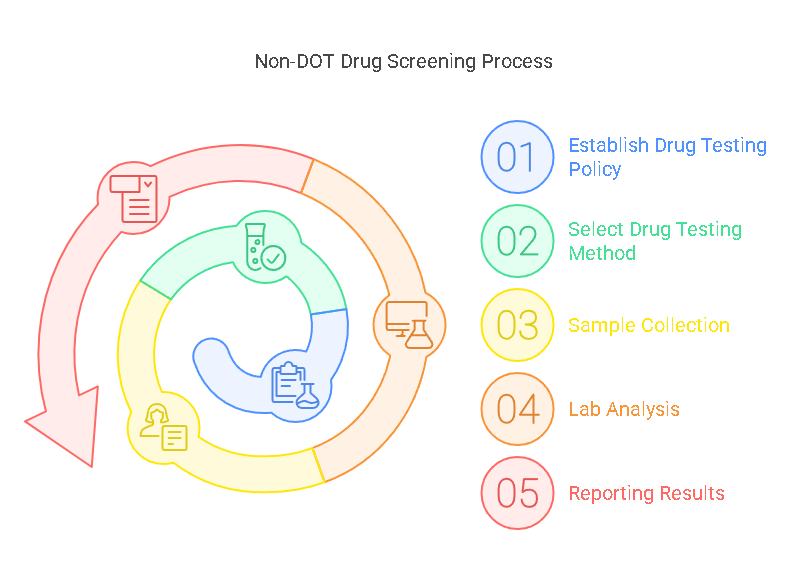
Implementing non-DOT drug screening involves several key steps that ensure the process is effective, compliant, and fair. The following step-by-step guide outlines the stages of non-DOT drug testing, from initial planning to final reporting.
- Establish a Drug Testing Policy
The first step in implementing non-DOT drug screening is for employers to establish a clear and comprehensive drug testing policy. This policy should outline when and how drug testing will occur, the substances that will be tested, and the procedures for handling positive results. It’s important for employers to ensure that the policy aligns with state and local laws while also reflecting the organization’s goals and values.
Employers must communicate this policy to all employees so that they are aware of the testing process. A written drug-free workplace policy is essential for legal protection and to set expectations for employees. Policies can also outline specific conditions under which testing will occur, such as pre-employment, random, reasonable suspicion, or post-accident testing.
- Select the Appropriate Drug Testing Method
Once the policy is in place, employers need to select the drug testing methods they will use. The most common types of non-DOT drug tests include:
- Urine Testing: This is the most commonly used method for drug testing. It is cost-effective, accurate, and capable of detecting a wide range of substances. Urine tests are typically used for routine testing such as pre-employment and random screenings.
- Hair Testing: Hair testing provides a longer detection window, usually up to 90 days. It is particularly useful for detecting long-term drug use. Employers who need to assess whether a candidate or employee has a history of drug use may choose this method.
- Saliva Testing: Saliva tests are non-invasive and easy to administer. They detect recent drug use, typically within the past 24-48 hours. This method is often used for random testing or when employers need quick results.
- Blood Testing: Blood tests are highly accurate but invasive and expensive. They are generally used in situations where precise measurement of drug levels is needed, such as after an accident or for legal purposes.
The choice of testing method will depend on factors such as the type of drug being tested for, the detection window required, and budgetary considerations.
- Sample Collection
The next step is sample collection. For non-DOT drug testing, this usually occurs on-site, particularly for urine or saliva tests. However, for hair and blood testing, employees may need to visit a certified medical facility. During collection, employers must ensure that the process respects the privacy and dignity of the employee.
For urine tests, individuals will be asked to provide a sample in a secure and private setting. Similarly, saliva tests are conducted with a swab from inside the mouth, and hair samples are collected by cutting a small portion of hair from the employee’s head or body.
For blood testing, a licensed healthcare professional will take the blood sample at a medical facility. The process must follow strict protocols to avoid contamination or tampering.
- Lab Analysis
Once the samples are collected, they are sent to a certified laboratory for analysis. Laboratories must follow strict guidelines to ensure the accuracy of the test results. In most cases, non-DOT drug tests will be sent to independent, certified laboratories that specialize in toxicology and drug testing.
Laboratories will typically use gas chromatography-mass spectrometry (GC-MS) or immunoassay technology to analyze the samples. These methods are known for their high accuracy and ability to detect a wide range of substances.
- Reporting the Results
After the samples are analyzed, the lab will send the test results to the employer. Results are typically categorized as either negative or positive, depending on whether drugs or alcohol were detected in the employee’s system.
If the result is negative, the employer can move forward with their hiring process or continue the employee’s employment without issue. If the result is positive, the employer may take disciplinary action in accordance with their policy. In some cases, the employee may have the opportunity to provide a valid explanation for the positive result, such as prescription medication use.
Employers should ensure that they have a process in place for handling positive results, which may involve a review of the employee’s situation, possible re-testing, or offering counseling or rehabilitation programs.
Key Differences Between Non DOT and DOT Drug Screening
While non-DOT drug screening offers more flexibility, it is essential to understand how it compares to DOT drug testing. Below is a comparison of the key differences between non-DOT and DOT drug testing:
| Criteria | Non-DOT Drug Screening | DOT Drug Screening |
|---|---|---|
| Regulatory Oversight | Subject to state and local laws | Governed by federal regulations (49 CFR Part 40) |
| Required for Employment | Not required by law, voluntary for employers | Required for safety-sensitive positions in transportation |
| Testing Frequency | Employer’s discretion | Specified frequency (e.g., random testing) |
| Substances Tested | Employer’s discretion, flexibility in substance panels | Specific list of drugs (e.g., marijuana, cocaine, opioids) |
| Testing Method | Urine, hair, saliva, blood | Primarily urine testing, with specific procedures |
| Record Keeping | Employer’s discretion | Strict record-keeping and reporting requirements |
| Reporting Requirements | Typically not standardized | Requires specific reporting to DOT and other authorities |
| Consequences for Positive Results | Employer discretion | Mandatory reporting and consequences (e.g., suspension, follow-up testing) |
As the table illustrates, non-DOT drug screening offers greater flexibility for employers in terms of testing frequency, substances tested, and reporting requirements. DOT testing, by contrast, is highly regulated and applies specifically to individuals in safety-sensitive positions within the transportation sector.
Benefits of Non DOT Drug Screening
Non-DOT drug screening provides a wide range of benefits for employers. The flexibility and reduced regulatory burden allow organizations to tailor their drug testing programs to suit their specific needs. Some key advantages of non-DOT drug screening include:
- Flexibility in Testing: Non-DOT drug testing allows employers to choose the substances they want to test for and the methods used to detect them. This flexibility is particularly valuable for industries that have unique safety concerns or specific risks associated with drug use.
- Cost-Effectiveness: Non-DOT drug screening is generally more affordable than DOT testing due to fewer regulatory requirements and the ability to choose cost-effective testing methods. Employers can select the testing methods that fit their budget while still ensuring a safe and compliant workplace.
- Improved Workplace Safety: By testing employees for drugs, employers can reduce the risk of accidents, injuries, and unsafe working conditions. A drug-free workplace is essential for ensuring that employees are alert, focused, and able to perform their tasks without impairment.
- Fewer Regulatory Hurdles: Non-DOT drug screening is not subject to the strict federal regulations that govern DOT testing. This means that employers have more control over the testing process and can customize it to their specific needs, making the process more streamlined and less burdensome.
- Enhanced Reputation: Companies that implement non-DOT drug testing can demonstrate their commitment to maintaining a safe and healthy workplace. This not only improves internal morale but can also enhance the company’s reputation with customers, stakeholders, and potential hires.
Challenges Employers May Face with Non DOT Drug Screening
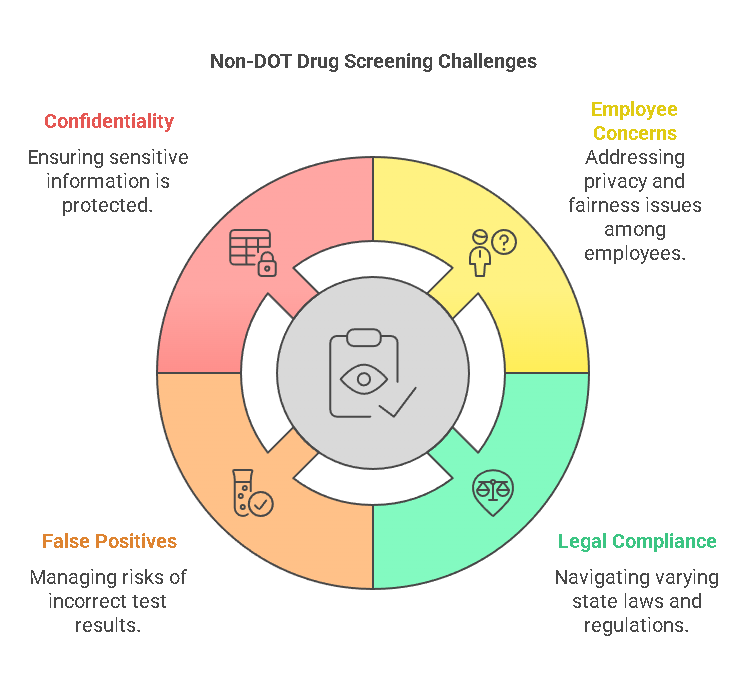
While non-DOT drug screening offers many benefits, employers may face several challenges when implementing drug testing policies. These challenges include:
- Managing Employee Concerns: Employees may be concerned about the privacy implications of drug testing, especially if they feel that the tests are invasive or unfair. Clear communication and transparency about the testing process can help alleviate concerns.
- Ensuring Compliance with State Laws: Non-DOT drug screening is subject to varying state laws and regulations. Employers must stay informed about the legal requirements for drug testing in their jurisdiction to avoid potential legal pitfalls.
- Addressing False Positives: There is always a risk of false positives in drug testing, which can lead to misunderstandings and disputes. Employers should have protocols in place to address these issues, including re-testing or offering employees the opportunity to explain a positive result.
- Maintaining Confidentiality: Drug test results are sensitive information, and employers must ensure that the results are handled confidentially and only shared with the necessary personnel.
How Precisehire Can Help with Non DOT Drug Screening
Precisehire offers comprehensive drug testing solutions for non-DOT screenings, helping businesses navigate the complexities of drug testing while ensuring compliance with local and state regulations. With a focus on accuracy, efficiency, and confidentiality, Precisehire assists employers in managing their drug screening programs from start to finish. Whether you need to implement random testing, pre-employment screenings, or post-accident testing, Precisehire provides customized solutions that suit your business needs. Their expert team ensures that all drug testing is done in a compliant, efficient, and cost-effective manner.

